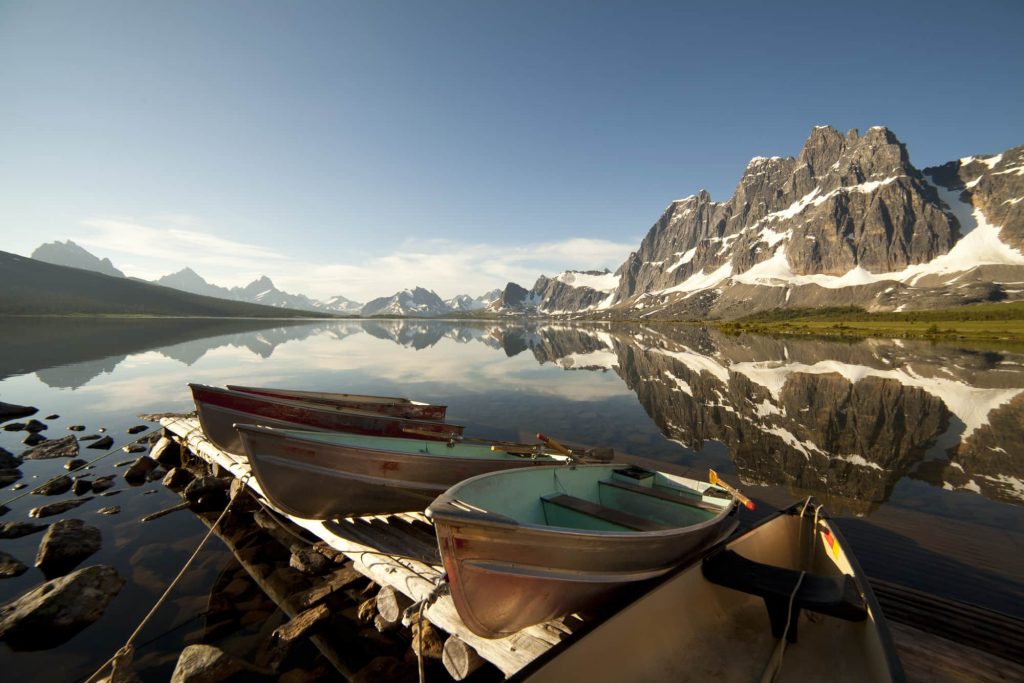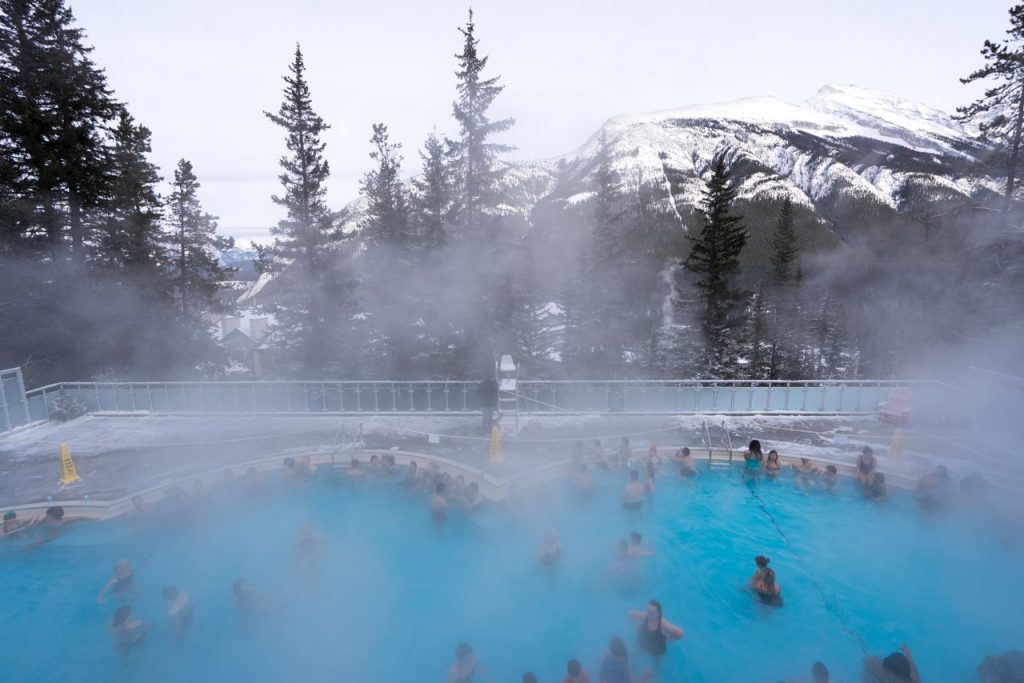Lake Louise is one of the most famous lakes in Alberta, Canada. Located in Banff National Park, come sun or snow, this natural water body can hold you in its mesmerizing grip. The cold may chill your bones, but the jagged peaks surrounding the shimmering waters will stir your soul. In a country that spends most of the year in negative temperatures, Alberta is where visitors can lose themselves to endless wonders made more majestic by winter.

It’s been an exciting time for Alberta. In recent years, travel publications like National Geographic Traveler, Condé Nast Traveler, New York Times, and even Vogue all listed this Canadian province as one of their top places for travel. But even before the buzz, Alberta was a force to be reckoned with.
After all, Banff and Jasper, two of the world’s oldest parks, can be found in this region, where, during the day, visitors can experience nature beyond their wildest dreams. At night, Alberta’s national parks are alluring for different reasons. They are perfect for hunting down northern lights and are home to dark sky preserves where humans can gape at stars in an environment without any artificial light.
Beyond picture-perfect sights for sore eyes, what you discover in Jasper or while visiting Banff and Alberta in winter will go beyond its snowy mountains and deeper than its pristine lakes. More often than not, when faced with the raw power of nature, when we feel the smallest in our awe, that is when we feel the most alive. Winter in Alberta has the potential to do that; it will make you feel alive with wonder and curiosity like nowhere else in the world.

Man-made game-changers
There are many places you can travel to for a stunning winter filled with both serenity and adventure, but Alberta is full of unique experiences that can’t be found in those destinations. This is something you will readily attest to after walking the frozen bubbles at Abraham Lake, a place where man and nature have fused.
Despite being an artificial lake, the waterbody plays host to a natural phenomenon that occurs when decomposed plants at the surface release methane. The methane turns into frozen bubbles, which become trapped below the icy façade that forms on top of the lake in negative temperatures. It’s like looking through a sheet of solid crystal clear glass at hundreds and thousands of bubbles, and you can even walk across it.

Earth’s greatest adventures
Other ways the cold heightens your senses in Alberta is by tempting you with exhilarating experiences against the snowy backdrop of the Rocky Mountains. Jasper National Park is one of the largest national parks in the Canadian Rockies. During the winter months, the rivers cascading into falls freeze into spectacular ice climbs in October, and later on in the year, the riverbed becomes frozen enough to explore on foot as well. However, if you’re a beginner, it’s a good idea to do this with a qualified guide who can take you along a safe route.
If you’re looking into tours around Alberta, pick one that will take you to Maligne Canyon, one of the deepest canyons in the Canadian Rockies, as the temperatures plummet, it transforms into a frozen cavern decked out in icicles and formations, all of which leads to a spectacular ice walk that’s out of this world. Globus offers one that will take you to Jasper for this and many other essential excursions like snowshoeing, skiing, hot springs, and sledding.

If snow, glaciers, and ice compel you, then you’ll find no shortage of such excursions in Alberta’s national parks. From hiking the Athabasca Glacier and skiing the Wapta Traverse to hitting the slopes in Banff National Park and driving alongside the breathtaking valleys of the Icefields Parkway, winter is the hottest season for unearthly adventures.
Athabasca Glacier is easily visible from the Icefields Parkway and is part of the colossal Columbia Icefield that straddles the divide between Banff and Jasper National Parks. It’s the most visited glacier in North America and for good reason! Guided tours will take visitors right up on the glacier, where the frosted vistas are sensational. Likewise, the Wapta Traverse is the only one of its kind in North America. This hut-to-hut skip trip is as enchanting (if not more) than similar routes revered in Europe, and Lake Louise Ski Resort in Banff National Park is considered one of the world’s most scenic regions for winter sports lovers from beginner to pro.

Experiences that go from bliss to one hundred
Channeling intrepid levels of adrenaline is not the only way to be spellbound in Alberta. The province may be tailor-made for winter adventures, but it’s prime for zen. UNESCO World Heritage Sites in this province are the norm (the region has five), and each one offers visitors an almost meditative experience. Why not melt away in the soothing geothermal mineral waters found in Alberta?
Tourists were first drawn to Banff for its renowned hot springs. Banff Upper Hot Springs, a revered thermal result of Sulphur Mountain, is the last hot springs open to the public. Relaxing in the pools during winter while watching the snow fall is meditative and magical, and there aren’t many places in the world where you can take a hot bath alongside mountain peaks. The Miette Hot Springs in Jasper National Park happens to be the warmest springs in the Canadian Rockies; the waters are an average temperature of 54°C (129°F). The idyllic views and drive along the wild Fiddle Valley to the hot springs are stunning.
Taking advantage of the ample tours available around the province is wise, this way, visitors cover plenty of ground and get more opportunities to immerse themselves in Alberta’s raw beauty. Evergreen offers a heavenly white Christmas and New Year tour, which starts in Calgary (a city that’s becoming more and more happening by the day). Go from relaxing in hot baths and sipping afternoon tea in Fairmont Banff Springs, the castle of the Rockies, to wishing your camera could match what the naked eye sees while driving along the Icefields Parkway and toasting the golden days of rail with a glass of champagne onboard an iconic train journey through the Canadian Rockies.

Winter wilderness wonderlands
Dinosaur Provincial Park lies in the Red Deer River valley, which is renowned for its badland topography. Formed over time into soft sandstone and rich with fossils, this site is one of the best places on the planet to look for your own relics. There are few places in the world where someone might want to brave the cold and camp during the winter, but Alberta’s Dinosaur Provincial Park is one of them. With the right gear, the contours here are a unique place to pitch a tent, observe the native wildlife, and get a fire going.
If you crave the kind of solitude that comes with the wilderness, winter is the perfect time to visit Waterton Glacier International Peace Park. The park shares a border with both Montana and Alberta and is staggeringly beautiful, with alpine scenery that can rival many mountainous regions.
From flora and fauna, soaring peaks, and deep canyons to glacial features, luscious foliage, and beasts such as bighorn sheep, mountain goats, and elk, the volume and quality of nature found at Waterton is remarkable. To get the most out of your visit, ride along The Waterton-Glacier Peace Park Loop, it’s an incredible way to see the dramatic landscape.

When the sun goes down
In Alberta, the days are alive with sights and sounds, but the nights become a living, breathing thing as a mystical force in the universe takes over the skies and colors them in hues and highlights of green, yellow, and purple. Home to the October Dark Sky Festival, it won’t come as a surprise that Alberta has some of the world’s largest dark skies, making it the perfect spot for stargazing and northern lights. It’s possible to see Mother Nature’s light show from September until May. Wood Buffalo (the world’s largest dark sky preserve) and Banff’s and Jasper’s national parks are popular locations. When the skies aren’t ablaze with the aurora borealis, they’ll gleam at you with meteors, the Milky Way, and other galactic treasures.
To experience both the northern lights and the Canadian Rockies in all their glory, it’s worth opting for a tour that takes you across the region. Intrepid Travel has curated a trip that starts in Edmonton and ends in Calgary. This tour makes visiting Banff and Alberta in winter a dream. You’ll explore many of Alberta’s highlights, some of which include glittering caverns and spotting moose, elk, and deer in Jasper, sleigh rides and trails around Lake Louise in Banff, dog-sledding in Canmore (a town with famous summits like Three Sisters and Ha Ling Peak), and northern lights in the town of Peace River.

Feed your senses
Bringing the senses into play in Alberta is easy. Along with thriving on fresh mountain air, you can feast on farm-to-table cuisine. Many of their ingredients and food have a story that’s intertwined with the region.
For example, bison is as old as the land (120,000 years, to be exact) and is a taste synonymous with Alberta. The cattle in the province feed on the region’s lush green pastures, and chefs know exactly what to do with it. Saskatoon berries are a staple winter food for indigenous people, they are made into teas or dried with bison for pemmican, enjoy them fresh or cooked into flavourful dishes. Another must-eat cold-weather staple is Alberta’s root vegetables. Cold weather causes the plant sugars in root vegetables to become concentrated, making them taste sweeter. Wash it all down with what you find in the microdistilleries, breweries, and wineries. They are recognized around the globe for what they’ve accomplished in taste and feats (Jasper Brewing Company was the first brewpub inside a Canadian national park).
Alberta’s culinary game is becoming known to the rest of the world, but the locals have been in on this secret for some time now. While we’ve been in the dark, they’ve been enjoying contemporary indigenous food, shopping for fresh local produce at year-round farmers markets, and eating inspired meals by pioneering chefs who are transforming Alberta’s culinary scene.
Where to begin your perfect Alberta winter
For a 90-minute drive from Banff, fly into Calgary. You could also opt to fly into Edmonton, which is three-and-a-half hours away from Jasper. Both are a gateway to adventure, but if you’re visiting Banff and Alberta in winter, Calgary is a good place to start. It’s a lively, cosmopolitan city with a burgeoning food and contemporary art scene. Also home to the Canada Olympic Park (located on the Trans-Canada Highway, which goes to Banff National Park), Calgary is a basecamp as exciting as everything that awaits visitors beyond the city.
Because in Alberta, perfection is a curious thing to behold. It’s how the depth of night comes to life with a force in the universe that swathes the skies in vibrant colors. The way nature surrenders to winter and becomes more magnificent for it. Where like a flake of snow, being a speck in the universe has never felt more lovely. But it’s also just finally standing in front of Lake Louise and letting yourself be.
This story was created in partnership with: Travel Alberta


